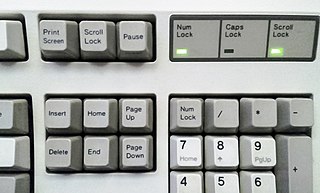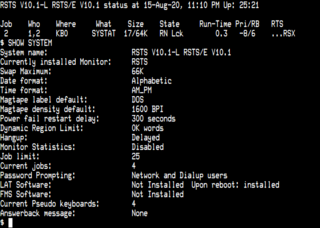Related Research Articles

Scroll Lock is a lock key on most IBM-compatible computer keyboards. Depending on the operating system, it may be used for different purposes, and applications may assign functions to the key or change their behavior depending on its toggling state. The key is not frequently used, and therefore some reduced or specialized keyboards lack Scroll Lock altogether.

VAX is a series of computers featuring a 32-bit instruction set architecture (ISA) and virtual memory that was developed and sold by Digital Equipment Corporation (DEC) in the late 20th century. The VAX-11/780, introduced October 25, 1977, was the first of a range of popular and influential computers implementing the VAX ISA. The VAX family was a huge success for DEC, with the last members arriving in the early 1990s. The VAX was succeeded by the DEC Alpha, which included several features from VAX machines to make porting from the VAX easier.

OpenVMS, often referred to as just VMS, is a multi-user, multiprocessing and virtual memory-based operating system. It is designed to support time-sharing, batch processing, transaction processing and workstation applications. Customers using OpenVMS include banks and financial services, hospitals and healthcare, telecommunications operators, network information services, and industrial manufacturers. During the 1990s and 2000s, there were approximately half a million VMS systems in operation worldwide.

RSX-11 is a discontinued family of multi-user real-time operating systems for PDP-11 computers created by Digital Equipment Corporation. In widespread use through the late 1970s and early 1980s, RSX-11 was influential in the development of later operating systems such as VMS and Windows NT.
RT-11 is a discontinued small, low-end, single-user real-time operating system for the full line of Digital Equipment Corporation PDP-11 16-bit computers. RT-11 was first implemented in 1970. It was widely used for real-time computing systems, process control, and data acquisition across all PDP-11s. It was also used for low-cost general-use computing.
DECnet is a suite of network protocols created by Digital Equipment Corporation. Originally released in 1975 in order to connect two PDP-11 minicomputers, it evolved into one of the first peer-to-peer network architectures, thus transforming DEC into a networking powerhouse in the 1980s. Initially built with three layers, it later (1982) evolved into a seven-layer OSI-compliant networking protocol.
This article presents a timeline of events in the history of computer operating systems from 1951 to the current day. For a narrative explaining the overall developments, see the History of operating systems.

A computer terminal is an electronic or electromechanical hardware device that can be used for entering data into, and transcribing data from, a computer or a computing system. Most early computers only had a front panel to input or display bits and had to be connected to a terminal to print or input text through a keyboard. Teleprinters were used as early-day hard-copy terminals and predated the use of a computer screen by decades. The computer would typically transmit a line of data which would be printed on paper, and accept a line of data from a keyboard over a serial or other interface. Starting in the mid-1970s with microcomputers such as the Sphere 1, Sol-20, and Apple I, display circuitry and keyboards began to be integrated into personal and workstation computer systems, with the computer handling character generation and outputting to a CRT display such as a computer monitor or, sometimes, a consumer TV, but most larger computers continued to require terminals.
OS/8 is the primary operating system used on the Digital Equipment Corporation's PDP-8 minicomputer.
Uptime is a measure of system reliability, expressed as the period of time a machine, typically a computer, has been continuously working and available. Uptime is the opposite of downtime.

RSTS is a multi-user time-sharing operating system developed by Digital Equipment Corporation for the PDP-11 series of 16-bit minicomputers. The first version of RSTS was implemented in 1970 by DEC software engineers that developed the TSS-8 time-sharing operating system for the PDP-8. The last version of RSTS was released in September 1992. RSTS-11 and RSTS/E are usually referred to just as "RSTS" and this article will generally use the shorter form. RSTS-11 supports the BASIC programming language, an extended version called BASIC-PLUS, developed under contract by Evans Griffiths & Hart of Boston. Starting with RSTS/E version 5B, DEC added support for additional programming languages by emulating the execution environment of the RT-11 and RSX-11 operating systems.
In computing, end-of-file (EOF) is a condition in a computer operating system where no more data can be read from a data source. The data source is usually called a file or stream.
A secure attention key (SAK) or secure attention sequence (SAS) is a special key or key combination to be pressed on a computer keyboard before a login screen which must, to the user, be completely trustworthy. The operating system kernel, which interacts directly with the hardware, is able to detect whether the secure attention key has been pressed. When this event is detected, the kernel starts the trusted login processing.

XNU is the computer operating system (OS) kernel developed at Apple Inc. since December 1996 for use in the Mac OS X operating system and released as free and open-source software as part of the Darwin OS, which, in addition to being the basis for macOS, is also the basis for Apple TV Software, iOS, iPadOS, watchOS, visionOS, and tvOS.

In some operating systems, including Unix-like systems, a pseudoterminal, pseudotty, or PTY is a pair of pseudo-device endpoints (files) which establish asynchronous, bidirectional communication (IPC) channel between two or more processes.
Signals are standardized messages sent to a running program to trigger specific behavior, such as quitting or error handling. They are a limited form of inter-process communication (IPC), typically used in Unix, Unix-like, and other POSIX-compliant operating systems.
QIO is a term used in several computer operating systems designed by the former Digital Equipment Corporation (DEC) of Maynard, Massachusetts.
The proc filesystem (procfs) is a special filesystem in Unix-like operating systems that presents information about processes and other system information in a hierarchical file-like structure, providing a more convenient and standardized method for dynamically accessing process data held in the kernel than traditional tracing methods or direct access to kernel memory. Typically, it is mapped to a mount point named /proc at boot time. The proc file system acts as an interface to internal data structures about running processes in the kernel. In Linux, it can also be used to obtain information about the kernel and to change certain kernel parameters at runtime (sysctl).
The magic SysRq key is a key combination understood by the Linux kernel, which allows the user to perform various low-level commands regardless of the system's state. It is often used to recover from freezes, or to reboot a computer without corrupting the filesystem. Its effect is similar to the computer's hardware reset button but with many more options and much more control.
References
- 1 2 Miller, David Donald (1997). Open VMS Operating System Concepts. Elsevier. p. 151. ISBN 978-1-55558-157-2.
- 1 2 RSTS/E System User's Guide (PDF). Maynard, MA: Digital Equipment Corportation. 1985. pp. 4–10. Archived (PDF) from the original on 2007-08-16.
- 1 2 Kerrisk, Michael (2010). The Linux Programming Interface: A Linux and UNIX System Programming Handbook. No Starch Press. p. 1299. ISBN 978-1-59327-291-3.
- ↑ Daniel G. Bobrow; Jerry D. Burchfiel; Daniel L. Murphy; Raymond S. Tomlinson (1971-08-15). "4.4 Interrupt Characters". TENEX, a Paged Time Sharing System for the PDP-10 (PDF) (Report).
- ↑ BASIC-PLUS-2 RSTS/E User's Guide (PDF). Maynard, MA: Digital Equipment Corportation. 1977. pp. 4–10. Archived (PDF) from the original on 2006-10-09.
- ↑ RSTS/E System User's Guide (PDF). Maynard, MA: Digital Equipment Corportation. 1979. pp. 4–13. Archived (PDF) from the original on 2005-03-29.
- 1 2 TOPS-10 Operation System Commands Manual. Maynard, MA: Digital Equipment Corporation. 1988. pp. 1–7. Archived from the original on 2017-12-04.
- TOPS-20 User's Guide. Maynard, MA: Digital Equipment Corportation. 1982. pp. 8–5. Archived from the original on 2017-12-04.
- ↑ TOPS-20 User's Guide. Maynard, MA: Digital Equipment Corportation. 1982. pp. 8–5. Archived from the original on 2017-12-04.
- ↑ "Re: ooh, a *real* flamewar :)". GitHub . 2000-03-24.
- ↑ "ITSTTY". GitHub .
- ↑ Peleg, Guy (2006-10-01). "OpenVMS Utilties Update" (PDF). OpenVMS News. Bruden On Shore Systems Group. Archived (PDF) from the original on 2017-12-06. Retrieved 2017-11-06.
- ↑ Karels, Michael J. (1989-08-26). "Computer Systems Research Group BSD Distribution signal.h 7.5". SCCS to fossil conversion of the original University of California, Berkeley Computer Systems Research Group BSD repository. Regents of the University of California. Retrieved 2017-12-05.
#define SIGINFO 29 /* information request */
- ↑ Teitelbaum, Marc (1989-10-26). "Computer Systems Research Group BSD Distribution tty.c 7.18". SCCS to fossil conversion of the original University of California, Berkeley Computer Systems Research Group BSD repository. Regents of the University of California. Retrieved 2017-12-05.
add ^T prototype
- ↑ Teitelbaum, Marc (1990-05-01). "Computer Systems Research Group BSD Distribution tty.c 7.22". SCCS to fossil conversion of the original University of California, Berkeley Computer Systems Research Group BSD repository. Regents of the University of California. Retrieved 2017-12-05.
^T
- ↑ – BSD General Commands Manual
- ↑ Lucas, Michael W (2015). Tarsnap Mastery. Tilted Windmill Press. p. 71.
- ↑ Lavigne, Dru (2004). BSD Hacks 100 Industrial Tip & Tools. O'Reilly Media. ISBN 978-0-596-55256-5.
- ↑ "BSD Overview". Apple, Inc. 2013-08-08. Retrieved 2022-03-13.
The BSD portion of the OS X kernel is derived primarily from FreeBSD
- ↑ "darwin-xnu/bsd/sys/ttydefaults.h". Github. Apple Computer, Inc. 2007-10-29. Retrieved 2017-12-05.
#define CSTATUS CTRL('t')
- ↑ "darwin-xnu/bsd/sys/signal.h". Github. Apple Computer, Inc. 2017-09-26. Retrieved 2017-12-05.
#define SIGINFO 29 /* information request */
- ↑ "darwin-xnu/bsd/kern/tty.c". Github. Apple Computer, Inc. 2017-09-26. Retrieved 2017-12-05.
Report on state of foreground process group.
- ↑ Bobrow, Daniel; Murphy, Daniel; Teitelman, W (April 1969). "Section 23.10". THE BBN - LISP SYSTEM REFERENCE MANUAL (PDF).